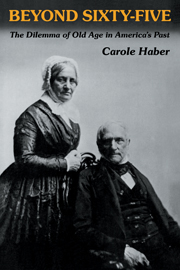Book contents
- Frontmatter
- Contents
- List of Tables
- Acknowledgments
- INTRODUCTION: Classifying Society's Superannuated
- CHAPTER ONE Aging in Colonial America
- CHAPTER TWO Social Realities and Perceptions of Old Age in the Nineteenth Century
- CHAPTER THREE Medical Models of Growing Old
- CHAPTER FOUR Treating the Postclimacteric Stage
- CHAPTER FIVE Institutionalizing the Elderly
- CHAPTER SIX The Pension Barrier
- CONCLUSION: Old Age in a Bureaucratic Society
- Notes
- A Note on Secondary Sources
- Index
CHAPTER FIVE - Institutionalizing the Elderly
Published online by Cambridge University Press: 26 February 2010
- Frontmatter
- Contents
- List of Tables
- Acknowledgments
- INTRODUCTION: Classifying Society's Superannuated
- CHAPTER ONE Aging in Colonial America
- CHAPTER TWO Social Realities and Perceptions of Old Age in the Nineteenth Century
- CHAPTER THREE Medical Models of Growing Old
- CHAPTER FOUR Treating the Postclimacteric Stage
- CHAPTER FIVE Institutionalizing the Elderly
- CHAPTER SIX The Pension Barrier
- CONCLUSION: Old Age in a Bureaucratic Society
- Notes
- A Note on Secondary Sources
- Index
Summary
In 1903, Homer Folks, commissioner of New York City's charities, announced a new policy for the City Almshouse. The institution would now be called the Home for the Aged and Infirm. Writing in the pages of Charities, Folks explained the reason. The change of name, he asserted, was based on the improved character of the inmates. In contrast to poorhouses of the past, New York's asylum was not filled with the lazy, corrupt, or able-bodied. Most of the residents were simply old and ailing. They had entered the poorhouse in order to receive badly needed food, shelter, and medical attention. “Observation and experience lead me to the conclusion,” Folks declared, “that we should regard the people with more consideration than we have been accustomed to give the inmates of the almshouse.” The adoption of a new name for the institution was thus intended to bring dignity to such aged sufferers. The institutionalized elderly would no longer be treated as disgraced paupers.
Folks's new policy was based on far more than the kindly sentiments of one charitable commissioner. It was not only the New York City Almshouse that appeared to be dominated by the old; almost every large city reported similar inmate populations. Nor was Folks unique in suggesting that “homes” might be created to shelter the aged and infirm. Throughout the nineteenth century, such private asylums had been established across the country, attracting the once middle-class elderly who had become incapable of providing for themselves.
- Type
- Chapter
- Information
- Beyond Sixty-FiveThe Dilemma of Old Age in America's Past, pp. 82 - 107Publisher: Cambridge University PressPrint publication year: 1983

